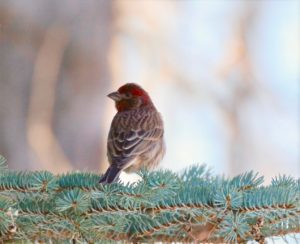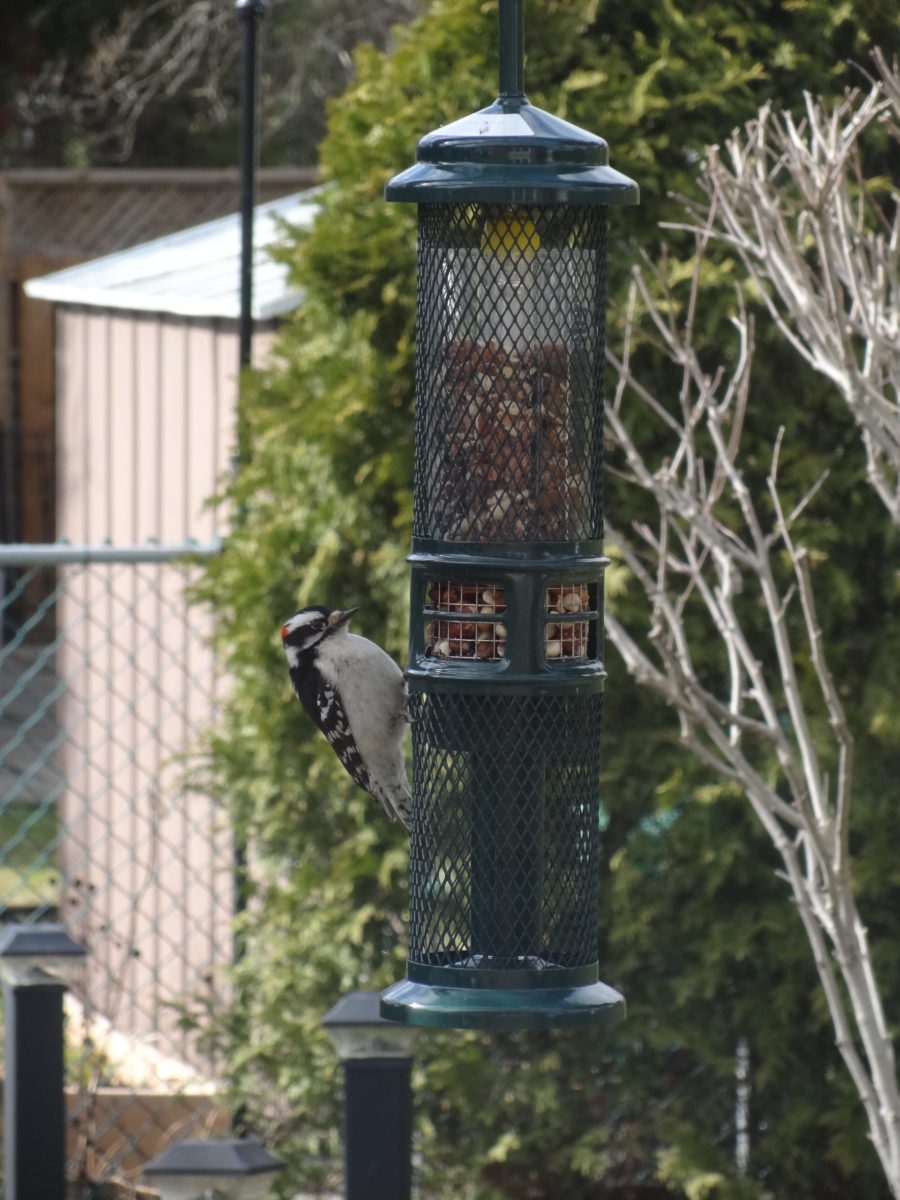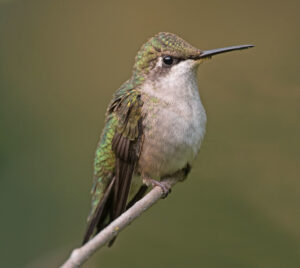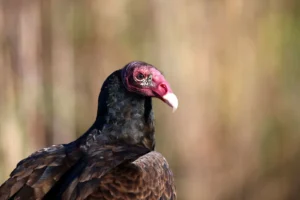By Robyn Maerz
The house finch sat listlessly below the bird feeder. Birds flew about, pecking at seeds, chirping loudly, and jostling each other for the best perches. But this house finch made no effort to eat or fly. Feathers fluffed up, its eyes were swollen and crusted; it was obvious the bird was very ill. AIWC was called, and soon the sick bird was on its way to the centre. After undergoing an exam and various tests, AIWC determined the finch was suffering from a condition called “House Finch Disease”. Although the home owner did not yet know it, the bird feeder itself was spreading the infection among the flocks of birds frequenting his garden.
Yes, you read that right. Bird feeders can “seed” infectious disease among our feathered friends! The main culprits are mouldy or decomposing seeds, bird droppings, and other foreign material that pile up on feeder trays. The hazard lies in what is IN that debris: bacteria, viruses and fungi, many of which are capable of causing infectious illness in our backyard birds.
What exactly is “House Finch Disease”?
In 1994, bird feeder aficionados started noticing house finches with swollen, red and crusty eyes in the Washington D.C. area. Tests revealed the cause was a bacterium called Mycoplasma gallisepticum, which until then had only been found in chickens. The disease had jumped to house finches, and started spreading rapidly across the United States and into Canada. Sadly, this condition has also been found in birds in the Calgary region. An afflicted bird will not die from the infection, but the birds are vulnerable to predators and starvation due to lacking energy blindness caused by the eye crusting[iii].

Other common contagions
Unfortunately, House Finch Disease is not the only risks that face birds at feeders. The most common disease encountered is Salmonella, which is a bacterial infection. Birds affected by Salmonella show symptoms such as diarrhea, ruffled feathers, and lethargy. A Salmonella infection can spread rapidly among birds that eat at crowded bird feeders, where they often ingest food spoilt by contaminated bird droppings. Sadly, an untreated infection of this kind can be deadly, and infected birds can die within 1 to 2 days[i].
Another potential illnesses at feeders is Aspergillosis, which is a fungus that can grow on damp bird seed. Birds inhale the fungal spores into their lungs and air sacs, causing pneumonia, bronchitis, and eventually leading to death.
Viral diseases such as “avian pox” can also be spread by feeder crowds. This virus causes sores that form on the un-feathered parts of a bird’s body, including areas such as in the mouth, on the feet and eyelids, and around the eyes. Avian pox spreads though direct contact with infected birds at the feeder, but also through the bites of mosquitoes that have already bitten an infected bird. Fortunately, except for birds whose sores block their vision, most birds survive avian pox[ii].
How can we help protect our backyard birds?
One of the best things we can do to protect our feeder birds is to keep our feeders clean! See the list of tips and tricks below to ensure your birds stay as healthy as possible.
- Clean your bird feeders every two to four weeks, and even more often during times of heavy use or wet weather. If you can, take your feeder apart and scrub all the parts thoroughly to remove caked on bird droppings and old bird seed. Soak the feeder in a solution of one part bleach to nine parts water for a few minutes. Rinse with plain water and let the feeder air dry. You can also wash the feeder with soap and water, but only the use of bleach kills bacteria such as Salmonella[iv] [v] [vi] [vii].
- If you notice uneaten food is gathering in or under your feeders, think about switching to a seed mix more to the birds’ liking.
- If you see birds fighting over space at a feeder, consider adding another feeder to relieve the crowding that may be promoting the spread of disease.[viii] Social distancing isn’t just for humans!
- Clean up old seed hulls and bird waste below the feeders and throw it in the garbage. This will also reduce the number of mice who frequent the area for a free seed snack.
- Ensure the seed you offer is fresh, and always store your bird seed in airtight containers to minimize spoilage. Don’t forget to wash your hands thoroughly before and after putting the new seed out!
- Don’t forget your hummingbird feeders either! In order to prevent the growth of mold or the start of deadly fermentation, change the sugar water every three to five days; more frequently in hot weather. Do not wash these feeders with soap and water as this can leave behind a harmful residue. Rinse them with a dilute bleach or weak vinegar solution, followed by a thorough washout with plain hot water. Let the feeder air dry before refilling it.[ix] [x]
Many bird lovers find feeding their back yard feathered friends a source of great joy. But danger lurks for birds where least expected, in a dirty bird feeder! Help keep them healthy by regularly cleaning your feeders, and spread the word among your bird feeding friends and neighbors!
References
[i] Oregon Department of Fish and Wildlife. 2017. “Keep Bird Feeders Clean: Dirty Feeders Can Spread Disease to Backyard Birds”. https://www.dfw.state.or.us/news/2017/12_dec/121817.asp. Accessed 07 November 2020
[ii] Mass Audobon. 2020. “Common Bird Parasites & Diseases”. https://www.massaudubon.org/learn/nature-wildlife/birds/common-bird-parasites-diseases. Accessed 08 November 2020
[iii] Project Feeder Watch. 2020. “House Finch Eye Disease”. https://feederwatch.org/learn/house-finch-eye-disease/. Accessed 08 November 2020.
[iv] Project Feeder Watch. 2018. “Preventing Disease: What’s the best way to clean your bird feeders?”. https://feederwatch.org/blog/cleaning-preventing-disease/ Accessed 08 November 2020
[v] Wild Birds Unlimited Nature Shop. 2020. “Bird Feeder Care & Cleaning”. https://www.wbu.com/bird-feeder-care-cleaning/ . Accessed 07 November 2020
[vi]Northeast Wildlife Disease Cooperative. 2017. “Avian Pox”. https://www.northeastwildlife.org/disease/avian-pox. Accessed 08 November 2020
[vii] Mantz, Melyssa. 2020. “Bird Feeder Cleaning Tips”. The Spruce. https://www.thespruce.com/bird-feeder-cleaning-tips-386563 Accessed 12 November 2020
[viii] Wild Bird Scoop. “How To Clean Bird Feeders: How Often and What Tools To Use”. https://www.wildbirdscoop.com/how-to-clean-bird-feeders.html Accessed 12 November 2020
[ix] All About Birds. 2009. “Cleaning Seed Feeders”; “Maintaining Hummingbird Feeders”. https://www.allaboutbirds.org/news/how-to-clean-your-bird-feeder/ Accessed 10 November 2020
[x] National Audobon Society. 2017. “Hummingbird Feeding FAQs”. https://www.audubon.org/news/hummingbird-feeding-faqs. Accessed 12 November 2020






